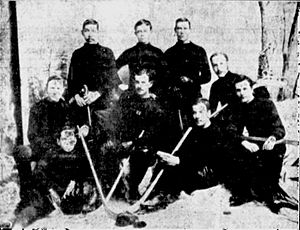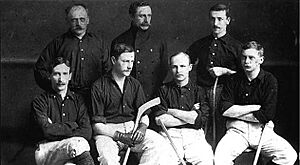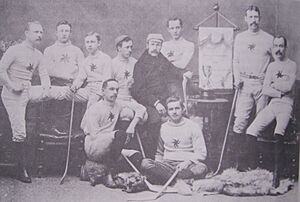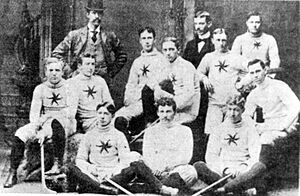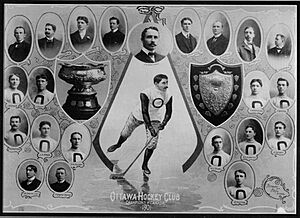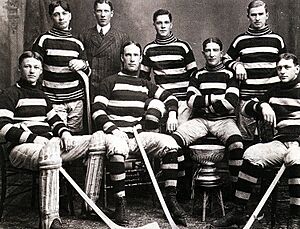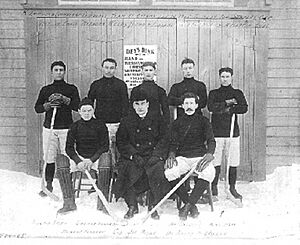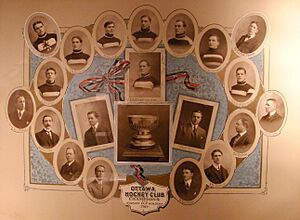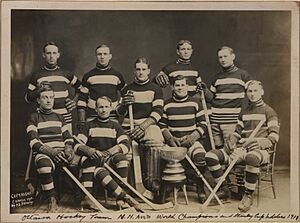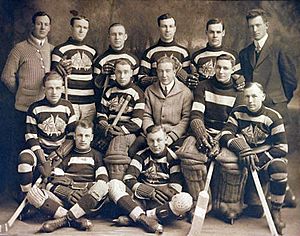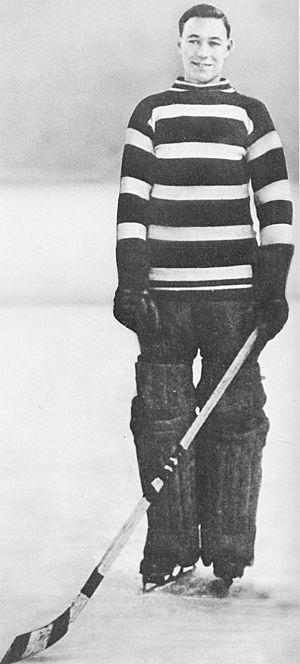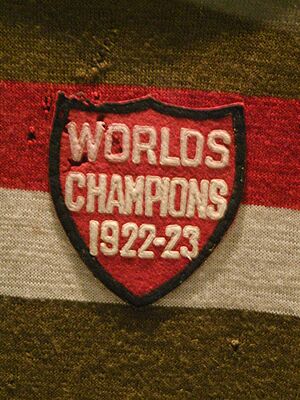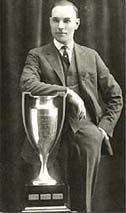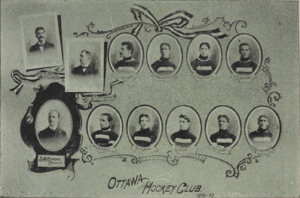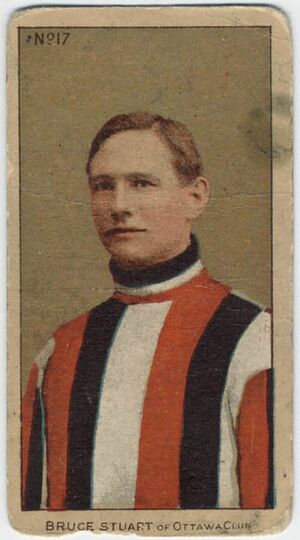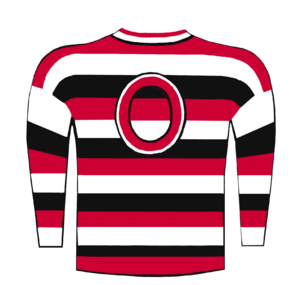Ottawa Senators (original) facts for kids
Quick facts for kids Ottawa HC |
|
|---|---|
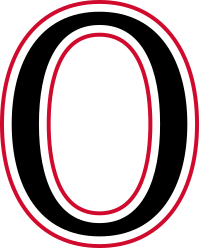 |
|
| Founded | 1883 |
| History |
|
| Home arena | Royal Rink (1883) Dey's Rink (1884–1887) Rideau Rink (1889–1895,1898) Dey's Arena (1896–1897,1898–1903) Aberdeen Pavilion (1904) Dey's Arena (1905–1907) The Arena (1908–1923) Ottawa Auditorium (1923–1954) |
| City | Ottawa, Ontario |
| Colours | Black, red, and white |
| Stanley Cups | 11 (1903, 1904, 1905, 1906, 1909, 1910, 1911, 1920, 1921, 1923, 1927) |
| Division championships | 8 NHL Canadian: 1927 NHA: 1911, 1915 CAHL: 1901 AHAC: (Jan-Mar 1892) OHA:1891,1892,1893 |
The Ottawa Senators were a famous ice hockey team from Ottawa, Canada. They played from 1883 to 1954. This club was the first hockey team in Ontario. They were also a founding member of the National Hockey League (NHL). The team played in the NHL from 1917 until 1934.
The club was officially called the Ottawa Hockey Club (Ottawa HC). They had many nicknames over the years. In the 1890s, they were called the Generals. From 1903 to 1907, they were known as the Silver Seven. After 1908, they became known as the Senators.
Hockey experts often say this club was one of the greatest teams in the early days of the sport. They won many championships. They won the Ontario championships from 1891 to 1893. Ottawa HC played in the first season where the Stanley Cup was challenged in 1893. They first won the Cup in 1903 and kept it until 1906. This was during their "Silver Seven" years.
The team also did very well in the 1920s. They won the Stanley Cup in 1920, 1921, 1923, and 1927. These were their "Super Six" years. In total, the club won the Stanley Cup 11 times. In 1950, Canadian sports writers voted the Ottawa HC/Senators as Canada's best team of the first half of the 20th century.
The club was one of the first organized hockey teams. They played in tournaments in Montreal in the early 1880s. They also helped start the Amateur Hockey Association of Canada and the Ontario Hockey Association. As hockey became more professional in the early 1900s, the club also became a professional team. They were founding members of the National Hockey Association (NHA) and later the NHL. The club played in the NHL until the 1933–34 season. Because of money problems, the NHL team moved to St. Louis, Missouri. There, they became the St. Louis Eagles. The club continued as an amateur team in Quebec until 1954. These "Senior Senators" won three Allan Cup titles.
Contents
Team History
Early Amateur Era (1883–1902)
The Ottawa Hockey Club (Ottawa HC) was started by a few hockey fans. After watching games at the 1883 Montreal Winter Carnival, Halder Kirby, Jack Kerr, and Frank Jenkins decided to form the club. It was the first organized ice hockey club in Ottawa and in Ontario. In their first winter, they only had practices at the "Royal Rink."
The club first played in a tournament at the 1884 Montreal Winter Carnival. This was seen as the Canadian championship back then. They wore red and black uniforms. Nelson Porter, who later became Ottawa's mayor, scored the club's first goal ever at this carnival. Frank Jenkins was the team's first captain. He later became president of the hockey club and of the Amateur Hockey Association of Canada (AHAC).
For the 1885 season, the team changed its colors to gold and blue. They went back to the Montreal tournament. Ottawa won its first game ever at the tournament against the Montreal Victorias. But they lost their last game to the Montreal Hockey Club (Montreal HC) and finished second. The 1886 Montreal tournament was canceled due to an illness. The club did not play another outside game until 1887.
Starting the AHAC League
On December 8, 1886, the first championship league, the Amateur Hockey Association of Canada (AHAC), was formed in Montreal. It included several clubs from Montreal, one from Quebec City, and the Ottawa club. Ottawa's Thomas D. Green was chosen as the league's first president.
The league did not have a set schedule. Instead, teams played in "challenge series." A team would hold the championship and play against other teams that challenged them. This continued until 1893. In the first 1887 season, Ottawa lost the only challenge game they played to the Montreal Victorias.
After that season, Ottawa HC stopped playing for a while. Their main rink, the Royal Rink, was changed into a roller skating rink. There weren't enough ice rinks. This changed when the Rideau Skating Rink opened in February 1889. P. D. Ross, who published the Ottawa Journal and played on the team, helped restart the team. In 1889, the club played only one exhibition game against a Montreal HC 'second' team.
In November 1889, the Ottawa Amateur Athletic Club (OAAC) opened. This building became the Hockey Club's headquarters. The Hockey Club became part of the Ottawa Amateur Athletic Association (OAAA). When the club started playing again in 1889–90, they wore new white sweaters with black stripes. They also had the OAAA's red "triskelion" logo. During this time, the club became known as the "Generals" because of their logo.
In the 1889–90 season, Ottawa HC played two competitive games. This number grew a lot the next season. In the 1890–91 season, the club played 14 games in three leagues. Ottawa HC helped start two new leagues: the Ottawa City Hockey League (OCHL) and the Ontario Hockey Association (OHA). They also rejoined the AHAC. Ottawa HC won the Ottawa and Ontario championships. They won two games against AHAC teams. However, they lost to the AHAC champion Montreal HC in their only challenge for that championship.
OHA Championships
The team was the OHA champion for the league's first three years. The first championship was played on March 7, 1891, at the Rideau rink. Ottawa won 5–0 against Toronto St. George's. The 1891 championship was the only OHA final played in Ottawa. Ottawa played the 1892 final in Toronto, beating Osgoode Hall 4–2. In 1893, the Toronto Granites did not show up for the championship game in Ottawa, so Ottawa won by default.
The club left the OHA in February 1894. This was because the OHA would not let them host the 1894 final in Ottawa. This disagreement caused a lasting split between Ottawa teams and the OHA. Ottawa teams still do not play in the OHA.
At a dinner to honor the 1892 OHA champions, Lord Stanley, the Governor General, announced his new trophy. This trophy is now known as the Stanley Cup. Former player and club president P. D. Ross was chosen by Lord Stanley to help manage the Cup.
Back in the AHAC League
Ottawa HC did not win a game in their return to AHAC challenge play in 1890–91. But in the next AHAC season, 1891–92, the club won the league championship. They held it for most of the season, from January 10 to March 7, 1892. The club took the championship from Montreal HC, who had been undefeated. Ottawa won five games in a row. Then Montreal won the championship back with a 1–0 score in the last challenge of the season. Montreal's win was their only win of the season and their only one in four games against Ottawa.
Lord Stanley, who often watched Ottawa HC games, thought losing the title after holding it all season was not fair. In his letter announcing the Stanley Cup, Stanley suggested that the AHAC start a "round-robin" regular season. The AHAC started this in the 1892–93 season. Ottawa lost their first game of that season to the Montreal Victorias on January 7, 1893. This loss was the one-game difference that led to Lord Stanley giving the first Cup to Montreal HC.
In 1893–1894, Ottawa HC finished tied for first place in the AHAC standings with three other teams. A playoff was set up in Montreal for the championship. Ottawa, Montreal HC, and Montreal Victorias played. These were the first Stanley Cup playoff games ever. Ottawa played in the final game. On March 23, 1894, at the Victoria Skating Rink, Ottawa and Montreal HC played for the championship. Ottawa scored first, but Montreal scored the next three goals to win 3–1. Ottawa captain Weldy Young fainted from being so tired at the end of the game.
From 1894 to 1900, the club did not win the league championship. They finished second several times and last once. For the 1896–97 season, the Ottawa club started using "barber-pole" style sweaters. These had horizontal stripes of black, red, and white. This style was used by the club until 1954. The only exceptions were in 1900 and 1901. Then, the team used a plain sweater with just the letter 'O' on the front. This was like the sweaters of the Ottawa Football Club, which was also part of the OAAA.
In 1898, the AHAC broke up. This happened because the league voted to let the Ottawa Capitals, a team from a rival group, join the AHAC. The senior-level teams, including Ottawa, Montreal HC, Montreal Victorias, and Quebec, left the AHAC. They formed the Canadian Amateur Hockey League (CAHL), leaving out the Capitals.
The club won the CAHL 1901 season title. This was their first league championship since winning the OHA in 1893. They thought about challenging the Stanley Cup champion Winnipeg Victorias. But they decided not to because it was late in the season.
Important players from this time included Albert Morel and Fred Chittick in goal. They were often the best goalies in the league. Future Hall of Famers like Harvey Pulford, Alf Smith, Harry Westwick, and brothers Bruce Stuart and Hod Stuart also played. It was during this time that the nickname Senators was first used. However, from 1903 to 1906, the team was better known as the Silver Seven.
Silver Seven Era (1903–1906)
The first great period for the Ottawa HC was from 1903 to 1906. During this time, the team was called the "Silver Seven." This era began when Frank McGee joined for the 1903 season. It ended when he retired after the 1906 season. McGee had lost an eye playing amateur hockey. But he was convinced to join the Senators even with the risk of losing his other eye. He was the youngest player on the team and was 5 feet 6 inches tall. He scored an amazing 135 goals in 45 games. In a 1905 challenge against the Dawson City, he scored 14 goals in one game, which they won 23–2. He retired in 1906 at only 23 years old.
In the 1903 CAHL season, Ottawa and the Montreal Victorias both finished in first place. They each had 6 wins and 2 losses. The two clubs played a two-game series to decide the league championship and Stanley Cup. The first game in Montreal ended in a 1–1 tie. The second game in Ottawa was played on ice covered with water. But Ottawa won 8–0. McGee scored three goals, and the three Gilmour brothers scored the other five. This win gave them their first Stanley Cup. From this point, the team held the Stanley Cup and beat all challengers until March 1906.
After winning the Stanley Cup, each player was given a silver nugget by team executive Bob Shillington. He was an Ottawa pharmacist and mining investor. He gave them nuggets instead of money because the players were still amateurs. Giving them money would have meant they couldn't play in the league. In 1957, Harry Westwick remembered that one player said, "We ought to call ourselves the Silver Seven." The name stuck. At that time, hockey teams had seven players on the ice: a goalie, three forwards, two defensemen, and a rover.
The Silver Seven played in three different leagues during this time. For a while, they were not part of any league. In February 1904, Ottawa left the CAHL because of a disagreement about replaying a game. The team had arrived late for a game in Montreal, and it was called a tie at midnight. The league wanted the game replayed. Ottawa agreed only if the game counted in the standings. This led to Ottawa leaving the league. For the rest of that winter, the club only played in Cup challenge series. The Cup's trustees decided that Ottawa still kept the Cup. The next season, Ottawa joined the Federal Amateur Hockey League (FAHL) and won its championship. Ottawa was only in the FAHL for one season. The Montreal Wanderers became their new rival. For the 1906 season, Ottawa, the Wanderers, and some CAHL teams formed the Eastern Canada Amateur Hockey Association (ECAHA). This brought the top teams into one league.
Playing Style
The Silver Seven were known for how many injuries they caused to other teams. In a Stanley Cup challenge game in 1904, the Ottawas injured seven of the nine Winnipeg players. The Winnipeg Free Press called it the "bloodiest game in Ottawa." The next team to challenge Ottawa, the Toronto Marlboroughs, were treated similarly. One newspaper said that Ottawa's style involved "slashing, tripping, the severest kind of cross-checking and a systematic method of hammering Marlboroughs on hand and wrists." This rough style of hockey continued for many years.
Dawson City Challenge
The Silver Seven played in one of the most famous Stanley Cup challenges. This was against Dawson City from the Yukon Territory in 1905. The Dawson City Nuggets team had traveled thousands of miles to get to Ottawa. They went by dog sled, train, and steamer boat. The journey was very difficult and took a long time. They arrived in Ottawa just two days before the first game.
Despite their tough trip, Ottawa refused to change the game date. The first game was close at first, with Ottawa leading 3–1 at halftime. In the second half, the game became rough. The game ended 9–2 for Ottawa. The Dawson City players felt unhappy, saying some goals were offside.
After the game, a Dawson City player said Frank McGee "doesn't look like too much." McGee had only scored once in the first game. But in the second game, McGee scored four goals in the first half and 10 in the second half. This led Ottawa to a 23–2 victory. His 14 goals in one game is still a record for major senior hockey. Eight of those goals were scored one after another in less than nine minutes. Even with this high score, newspapers said the Dawson City goalie played a "really fine game." Ottawa celebrated by hosting a dinner for Dawson City. After this, the players tried to drop-kick the Cup over the Rideau Canal. The Cup landed on the frozen ice and had to be found the next day.
Stanley Cup Challenge Win Streak
The Ottawas were the best team for three years. They won many challenges:
- In 1903, they beat Montreal Victorias to win the CAHL championship and the Stanley Cup.
- They beat Rat Portage Thistles in 1903.
- They beat Winnipeg Rowing Club in 1903–04.
- They beat Toronto Marlboroughs in 1904.
- They beat Montreal Wanderers by forfeit in 1904.
- They beat Brandon, Manitoba in 1904.
- They beat Dawson City in 1905.
- They won the 1905 FAHL championship.
- They beat Rat Portage Thistles in 1905.
- They beat Queens University in 1906.
- They beat Smiths Falls, Ontario in 1906.
The winning streak ended in March 1906. Ottawa and the Montreal Wanderers tied for the ECAHA league lead. They played a playoff series for the league championship and the Cup. Montreal won the first game 9–1. In the second game in Ottawa, Ottawa almost caught up, getting a 9–1 lead to tie the series. But then Lester Patrick of the Wanderers scored two goals to win the series 12–10. This was Frank McGee's last game, and he scored two goals.
- The Players
Besides McGee, many future Hall of Fame players played for the Ottawas. These included Billy Gilmour, Percy LeSueur, Harvey Pulford, Alf Smith, Bouse Hutton, and Harry Westwick. Alf Smith was also the coach.
Early Professional Era (1907–1917)
Becoming Professional (1907–1910)
Before the 1906–07 season, players were not paid to play hockey. The team followed amateur sports rules. Ottawa HC had an advantage because players could work for the government, which allowed them to play for the team. In the United States, the International Professional Hockey League (IPHL) was paying players. So, the ECAHA started to allow professional players. This meant top teams could compete for the best players. The only rule was that each player's status (amateur or pro) had to be announced.
During this time, the rivalry between the Senators and the Wanderers continued. It was sometimes very rough. On January 12, 1907, a big fight happened between the two teams in Montreal. Police arrested some Ottawa players on their next visit to Montreal. They were fined. The Wanderers won the return game in Ottawa in March and went undefeated that season. Ottawa finished second.
The 1907–08 season brought changes for Ottawa. Harry Smith and Hamby Shore left. Ottawa hired new players like Marty Walsh, Tommy Phillips, and Fred 'The Listowel Whirlwind' Taylor. Taylor was hired from the IPHL for the 1908 season for $1000 and a guaranteed government job. He was an instant hit and got the nickname 'Cyclone' for his fast skating. Phillips was signed for an even higher salary of $1,500.
Ottawa moved into their new rink, simply called The Arena. It could hold 4,500 seated fans and 2,500 standing. With new players and the new arena, Ottawa started selling season tickets. They sold 2,400 tickets. The home opener against the Wanderers on January 11 had 7,100 fans. Ottawa won 12–2. However, Ottawa started the season with two losses and finished second behind the Wanderers. Walsh tied for the scoring lead with 28 goals in 9 games.
In 1908–09, the Eastern Canada Amateur Hockey Association became fully professional. It changed its name to the Eastern Canada Hockey Association (ECHA). This caused some stars to retire, like Ottawa's Harvey Pulford, who wanted to stay amateur. Ottawa lost other players too. But the club brought in Bruce Stuart and Fred Lake. This team had a great season, winning 10 out of 12 games. Walsh led all scorers with 38 goals in 12 games. The season ended with a win against the Wanderers on March 3 in Ottawa, 8–3. Ottawa won the league and the Stanley Cup.
Important players from this time who are now in the Hall of Fame include Percy LeSueur, Dubby Kerr, Tommy Phillips, Harvey Pulford, Alf Smith, Bruce Stuart, Fred 'Cyclone' Taylor, and Marty Walsh.
National Hockey Association (1910–1917)
The 1909–10 hockey season saw big changes. The ECHA split into two groups: the Canadian Hockey Association (CHA) and the National Hockey Association (NHA). The NHA was started by millionaire J. Ambrose O'Brien and the Wanderers. The NHA became the league that led to today's National Hockey League.
Ottawa was one of the teams that started the CHA. But after a few games with low attendance, Ottawa and the Montreal Shamrocks left the CHA to join the NHA. Ottawa, as the defending Stanley Cup champion and rival of the Wanderers, was quickly accepted by the NHA. This allowed Ottawa to continue its rivalry with the Wanderers. The Wanderers won the championship in 1910. Ottawa won in 1911 and 1915.
During the NHA period, the nickname "Ottawa Senators" became common. Even though there was another Senators club in 1909, and the nickname was used as early as 1901, the club didn't officially adopt it. The official name Ottawa Hockey Club stayed until the 1930s.
Star player Cyclone Taylor went to Renfrew. Ottawa managed to keep their other top players. In February 1910, Taylor promised to score a goal while skating backward against Ottawa. This created huge interest, with over 7,000 fans attending. Ottawa won 8–5 and kept Taylor from scoring. Later in the season, Taylor did score a goal backward in Renfrew. This was the last game of the season, and Ottawa lost 17–2.
In 1910–11, the NHA set a salary cap. Many Ottawa players threatened to form a new league. But team owners controlled the rinks, so players accepted the new rules. Ottawa players still got bonuses after the season. Ottawa beat Renfrew 19–5. The team went 13–3 to win the NHA and the Stanley Cup. Marty Walsh and Dubby Kerr led in scoring. After the season, Ottawa played two challenges, winning both. In one game, Marty Walsh scored ten goals. 1910–11 was the first season for right wing Jack Darragh, who scored 18 goals.
From 1911–12 to 1913–14, both Ottawa and the Wanderers declined. After Renfrew left the league in 1911, the two clubs fought over Cyclone Taylor. He wanted to return to Ottawa, where his fiancée lived. The NHA had given Taylor's rights to the Wanderers. Ottawa insisted on playing Taylor in one game against the Wanderers. The Senators won the game, but Taylor didn't play well. The league ruled that the game had to be replayed. The Senators lost the replay, and it cost them the league championship. They finished second by one game behind Quebec. Quebec won the Stanley Cup that season and the next. The Toronto Blueshirts won in 1914. Taylor did not play in the NHA again. The Senators finished fifth in 1912–13 and fourth in 1913–14. Punch Broadbent started playing in 1912–13, scoring 20 goals.
In 1914–15, Ottawa and the Wanderers both returned to the top of the league. They tied for the NHA season title. This was also the season that future Hall of Famer Clint Benedict became the Senators' top goalie. Former Wanderer Art Ross joined the Senators. Ottawa won a two-game playoff, 4–1. The Senators then played in the first inter-league Stanley Cup final playoff series. They played against the Vancouver Millionaires of the Pacific Coast (PCHA) league. Cyclone Taylor, now with the Millionaires, scored six goals in three games. Ottawa lost three straight games in Vancouver. Future Senator center Frank Nighbor played for Vancouver in this series and scored five goals.
In 1915–16, the Senators finished second to the Montreal Canadiens, who won the Stanley Cup. Punch Broadbent left the team to fight in World War I. Frank Nighbor joined the Senators and became the team's top scorer. Nighbor was signed from Vancouver for $1,500, making him the highest-paid player. Benedict was the NHA's best goalie for the first time. Due to the war, some older players like Rat Westwick and Billy Gilmour tried to come back but only played two games.
In the off-season, Ottawa's president wanted to stop the team's operations until the war ended. Ticket sales had dropped. The other NHA owners refused. So, the team was given to Ted Dey, owner of the Arena. Dey cut player salaries and let players go, including Art Ross. Dey also fired manager Alf Smith.
In 1916–17, the last NHA season, Ottawa won the second half of the schedule. An Army team, the Toronto 228th Battalion, joined the league. When they left for war, the other Toronto team was suspended. Its players were sent to other teams, including Corb Denneny, who joined the Senators. His brother, future Hall of Famer Cy Denneny, had joined the Senators earlier that season. He stayed with the Senators until 1928. Benedict was the NHA's top goalie again. Nighbor tied for the scoring lead with 41 goals. As second-half winners, the Senators played against the Canadiens, who won the first half. The Senators lost a two-game playoff series to the Canadiens. This season saw the final decline of Ottawa's old rivals, the Wanderers. The next year, the Wanderers played only four games in the NHL before their arena burned down and the team folded.
World War I affected all NHA teams. But Ottawa managed to keep players and stay competitive. The club finished no worse than second during the war years.
Stanley Cup Champions in 1906 and 1910: A Debate
Because of the "challenge" format of Stanley Cup play before 1915, there's some confusion about how many Stanley Cups the Senators should be credited with: nine, ten, or eleven. The Senators were clearly Stanley Cup champions at the end of nine hockey seasons. In two other seasons, 1905–06 and 1909–10, the Senators won Stanley Cup challenges but were not champions at the very end of the season.
The Hockey Hall of Fame and the National Hockey League agree that the 1906 Senators were champions. But they disagree on whether the Senators were champions in 1910. In both seasons, the Senators were the defending champions. During those seasons, they won Stanley Cup challenges. However, by the end of both seasons, they no longer held the Stanley Cup.
In 1906, Ottawa beat Queen's University and Smiths Falls in Stanley Cup challenges. But Ottawa tied the Montreal Wanderers for the ECAHA regular season championship. To decide the ECAHA championship and the Stanley Cup, the Senators played a two-game series against the Wanderers in March 1906 and lost. The 1906 hockey season ended with the Wanderers as the Stanley Cup champions. The Hockey Hall of Fame and the NHL both recognize Ottawa and the Wanderers as champions for that year.
In January 1910, Ottawa beat Galt and Edmonton in Stanley Cup challenges. At the end of the season, Ottawa gave up the Cup to the Montreal Wanderers, who were the regular-season champions of the new NHA league. Unlike the 1906 case, the Hockey Hall of Fame does not recognize the Senators as champions for January 1910, but the NHL does.
In October 1992, at the first game of the current Ottawa Senators NHL club, banners were raised for nine Stanley Cups. This did not include 1906 and 1910. The club's media guides also listed the original Senators as nine-time winners. This changed in March 2003. The team then raised banners for the 1906 and 1910 years, joining the other nine. The club and the NHL now list the original Senators as 11-time winners.
NHL Years (1917–1934)
After struggling during the war, the Ottawa Hockey Association put the club up for sale for $5,000 in 1917. Montreal Canadiens' owner George Kennedy helped Ottawa Citizen sports editor Tommy Gorman buy into the Senators. Gorman, along with Martin Rosenthal and Ted Dey, bought the club. At a meeting in Montreal, the Senators, Canadiens, Wanderers, and Bulldogs formed a new league: the National Hockey League. This left a rival owner, Eddie Livingstone, by himself in the old NHA. Gorman represented the Senators at the meeting. Within a year, Gorman and Ted Dey had made enough money to pay back Kennedy.
The Senators' first season in the NHL, 1917–18, did not go well. Player salary disagreements delayed the home opener on December 19, 1917. The Senators lost their home opener 7–4. The Senators lost their rival, the Wanderers, after five games. The team struggled and finished third in the first half of the season. The club made player changes. Hamby Shore died of pneumonia in October 1918. Cy Denneny led the team, finishing second in league scoring with 36 goals.
Before the 1918–19 season, the Senators' ownership changed. Ted Dey became the main owner of both the Arena and the hockey club. Dey's actions also helped the NHL in its fight against the old Blueshirts owner. The Senators made an agreement with other NHL clubs. This agreement tied them to the NHL for the next five years and kept any rival league out of their arenas.
In 1918–19, the Senators won the second half of the split schedule. Clint Benedict had the best goalie average. Cy Denneny and Frank Nighbor were third and fourth in scoring. The schedule was shortened. The Senators and Canadiens played in the first best-of-seven series. Ottawa lost the first three games without star center Frank Nighbor. Ottawa asked to use another player, but the Canadiens said no. Nighbor returned for the fourth game, which Ottawa won 6–3. The series ended in five games, with the Canadiens winning the final game 4–2. The Stanley Cup final between Montreal and Seattle was stopped because of an influenza outbreak.
The 'Super Six' (1920–1927)
The "Super Six" Senators of the 1920s are seen as the NHL's first great team. The club won four Stanley Cups and finished first in the regular season seven times. The team's success came from good scoring by forwards like Frank Nighbor and Cy Denneny. They also had a strong defense. This led to the NHL changing rules in 1924 to make defensemen leave the defensive zone once the puck was out. Ottawa had many talented players. The Senators traded two future Hall of Famers (Clint Benedict and Punch Broadbent) in 1924 to make room for two new players (Alex Connell and Hooley Smith), who also became Hall of Famers.
In the 1919–20 season, the NHL brought back the Quebec Bulldogs team. The NHL now had four teams. There were no playoffs. Ottawa won both halves of the schedule, becoming the NHL champion and winning the O'Brien Cup. Clint Benedict again had the best goalie average. Frank Nighbor was third in scoring with 25 goals.
The Senators then played the Seattle Metropolitans for the Stanley Cup. Seattle's uniforms were similar to Ottawa's. So, the Senators played in simple white sweaters with a large red "O" for this series. The first three games were in Ottawa. The ice was slushy because of warm weather. NHL president Calder moved the series to Toronto, which had an artificial ice rink. Seattle won game four to tie the series. In the fifth and deciding game, Ottawa won 6–1 with Jack Darragh scoring three goals. They won their first Stanley Cup as an NHL team. After this win, T. P. Gorman called the team the 'Super Six.' See the article 1920 Stanley Cup Finals.
In the 1920–21 season, the league moved two Senators players to other teams to help balance the competition. Even without them, the Senators won the first half of the season. By the end of the playoffs, both players were back with Ottawa. Benedict again led the league in goalie average. Cy Denneny was second in scoring with 34 goals. The Senators beat Toronto 7–0 in a two-game playoff. Then they went west to play Vancouver for the Stanley Cup. The series had huge crowds, with 11,000 fans at the first game. Ottawa won the series with scores of 1–2, 4–3, 3–2, 2–3, and 2–1. Jack Darragh scored the winning goal. See the article 1921 Stanley Cup Finals.
The 1921–22 season saw new defensemen Frank Boucher and Frank "King" Clancy join the team. Clancy's first goal came on his first shot. Broadbent and Cy Denneny, called the "Gold Dust Twins", finished first and second in league scoring. They scored 59 of Ottawa's 106 goals. Broadbent scored in 16 games in a row, an NHL record that still stands. The Senators won the regular season title but lost to the Toronto St. Patricks in the playoffs.
In 1922–23, the Senators were led by top goalie Clint Benedict, scorer Cy Denneny, and the return of Jack Darragh. Defenseman Lionel Hitchman also started playing. Frank Nighbor set a record by playing six games in a row without being substituted. The Senators won the regular season and beat the Canadiens in the playoffs.
The Cup Final playoffs changed. There were semi-finals against the PCHA champion, then the final against the WCHL champion. In the Cup semi-finals, Ottawa again played Vancouver (now called the Maroons). New attendance records were set. Ottawa won the series. The Senators then played Edmonton and won in two games. The second game of the finals is famous because King Clancy, then a substitute, played all positions, including goalie. See the article 1923 Stanley Cup Finals.
That year, club owners Dey and Gorman partnered with Frank Ahearn. Ahearn's family owned the Ottawa Electric Company. Ted Dey then sold his share of the club and retired. The first thing the new partnership did was build a new arena, the Ottawa Auditorium. It had 7,500 seats and artificial ice. The new Auditorium's first game was on December 26, 1923. A crowd of 8,300 fans watched a game against the Canadiens.
The 1923–24 season saw the Senators win the season but lose the playoff to the Canadiens. Frank Nighbor was the first winner of the Hart Trophy as 'most valuable player.' After the playoff loss, goalie Clint Benedict was traded, along with Harry Broadbent, to the new Montreal Maroons. Ottawa hockey fans got to see a Stanley Cup final game in Ottawa. The Auditorium hosted the final game between the Canadiens and the Calgary Tigers.
The 1924–25 season saw big changes in Ottawa's team. Jack Darragh retired and later died. Alex Connell replaced Benedict in goal. Hooley Smith replaced Broadbent. Lionel Hitchman was sold to the Boston Bruins. Frank Finnigan also started playing. Off the ice, Gorman and Ahearn had disagreements. In January 1925, Gorman sold his share of the Senators to Ahearn and left.
With all the changes, the Senators dropped to fourth place. Cy Denneny continued to score many goals. Frank Nighbor became the first winner of the Lady Byng Trophy for fair play. This trophy was given by Lady Byng, the wife of the Governor General of Canada. Nighbor won the trophy in 1925–26 and 1926–27 as well.
The NHL expanded more into the United States in the 1925–26 season. Ottawa won the league title, led by Alex Connell in goal, who had 15 shutouts. Cy Denneny scored 24 goals. The team got a bye to the playoff finals. However, the Montreal Maroons won the series. Former Senator Clint Benedict was the goalie for the Maroons. The Maroons went on to win the Stanley Cup. The season also saw the first game for future Hall of Famer Hec Kilrea.
The 1926–27 season was the first time the NHL was divided into two divisions. Ottawa made the playoffs, winning the Canadian Division title. They beat the Canadiens to face the Boston Bruins for the Cup. In the first Stanley Cup series with only NHL opponents, Ottawa beat Boston. The final game was in Ottawa. It was the Senators' last Stanley Cup championship. Alex Connell was great in goal, allowing only three goals. Cy Denneny led in scoring with four goals, including the Cup winner. The Senators won three trophies: the Stanley Cup, the O'Brien Cup, and the Prince of Wales Trophy. After the series, the Senators players had a parade in Ottawa. See the article 1927 Stanley Cup Finals.
Decline (1927–1934)
Ottawa was the smallest market in the NHL, even before American teams joined in 1924. The city of Ottawa had only about 110,000 people in 1931. This was about one-fifth the size of Toronto, the league's second-smallest market. The team started asking the league for money help as early as 1927. Even after winning the Stanley Cup, the Senators were losing money. The league's expansion to the United States did not help the Senators. Few people came to games against the new American teams. Travel costs for away games were also higher. To try to make more money, the team played "home" games in other cities.
In the 1927–28 season, the Senators played two "home" games in Detroit. This helped them make a profit that season. Goalie Alex Connell set an NHL record (still unbroken as of 2021) of six shutouts in a row.
To get money, the Senators sold their star right wing Hooley Smith to the Montreal Maroons for $22,500. They also got back former star Punch Broadbent. The team also sent long-time player Cy Denneny to the Bruins. The club again played two "home" games in Detroit. They missed the playoffs for only the third time as an NHL team.
In the 1929–30 season, the team was still losing money. They moved some home games to Atlantic City, Detroit, and Boston. However, the Senators made the playoffs for the last time. They finished third in the Canadian Division. The Senators played against the New York Rangers. In the last NHL playoff game in Ottawa until 1996, the Senators tied the Rangers 1–1 on March 28, 1930. But they lost game two in New York 5–1, losing the series 6–2. This season also saw the first game for future star Syd Howe with the Senators. Long-time star Frank Nighbor was sold to Toronto.
By the 1930–31 season, the team was openly selling players to make money. Star defenseman King Clancy was sold to Toronto for $35,000 and two players. The team fell into last place for the first time since 1898. In 1931, there was a chance to move the team to Chicago. But the Chicago Black Hawks owner did not want another team in his area and stopped the deal.
The Senators and another struggling team, the Philadelphia Quakers, asked the NHL if they could stop playing for the 1931–32 season. They wanted to rebuild their team. The league agreed to both requests. Ottawa received $25,000 for letting other teams use its players. The NHL also helped the club get a loan. The Senators thought about moving to Toronto. But they did not agree on the terms.
The Quakers never returned, but the Senators started playing again after one year. Even with players like Cooney Weiland, Finnigan, Howe, and Kilrea back, the Senators had the worst record in the league for the next two seasons. Few people came to their games. Frank Finnigan remembered playing home games for small crowds of 3,500 to 4,000 fans. 1932–33 saw Cy Denneny return to Ottawa as coach. He only stayed for one season. In June 1933, former captain Harvey Pulford had an option to buy the team and move it to Baltimore, but it never happened. In October 1933, Kilrea was sold to Toronto for $10,000.
In December 1933, there were rumors that the Senators would combine with the struggling New York Americans. But Ottawa club president Frank Ahearn denied this. The team played the full 1933–34 season, moving one home game to Detroit. Near the end of the season, reports said the club had made a deal to move the team. The team lost its last home game 3–2 to the Americans on March 15, 1934. The crowd was throwing "carrots, parsnips, lemons, oranges and several other unidentified objects onto the ice." The final game of the season was a 2–2 tie with the Maroons in Montreal on March 18, 1934.
1934: End of the First NHL Era in Ottawa
Even though they finished last for the second year in a row, the Senators actually had more fans than the season before. But even with more ticket sales, they barely made it through the season. After the season, it was announced that the team would not return to Ottawa for the 1934–35 season. They had lost $60,000 in two seasons. The NHL team moved to St. Louis, Missouri and became the St. Louis Eagles. The Eagles played only one season, finishing last again. They stopped playing after that season and never returned. Flash Hollett was the last former Senator to play in the NHL, retiring in 1946.
The city of Ottawa did not have an NHL team again until the new Ottawa Senators team was started for the 1992–93 season. The NHL gave the new Senators a "certificate of reinstatement" to mark Ottawa's return to the league. The current Senators honor the original team's 11 Stanley Cups. However, the records for the two teams are kept separate. Frank Finnigan, the last living member of the original Senators' last Stanley Cup win, helped bring a new team to Ottawa. He was supposed to drop the puck for the new team's first game but passed away a year before. The new Senators honored Finnigan by retiring his #8 jersey.
After the NHL team moved, the Senators continued as a senior amateur club in the Quebec Amateur Hockey Association (QAHA). This started in the 1934–35 season. One player, Eddie Finnigan, played for both the Senators and the Eagles in that season. The "Senior Senators" continued their rivalry with Montreal amateur teams. Later, Tommy Gorman bought the team. He operated the senior team until December 1954. He closed the team because fewer people were coming to games, blaming the "rise of hockey on television." This finally ended the Senators' 71-year history.
Team Information
Nicknames
The club started in 1883 as the Ottawa Hockey Club. It was officially known by that name. In the 1890s, reports sometimes called the club the Generals. They were also called the Capitals, but there was another team with that name. Other nicknames included the Silver Seven. Players gave themselves this name after getting silver nuggets from manager Bob Shillington after their 1903 Stanley Cup win. The Super Six name was used in the 1920s.
The nickname Senators was first used in a newspaper report on January 7, 1901. While the nickname was used sometimes, the club was still mostly known as the Ottawa Hockey Club. In 1909, a separate Ottawa Senators professional team existed. Ottawa newspapers called that club the Senators. The Globe newspaper first called the Ottawa Hockey Club the Senators in an article on December 30, 1912. Eventually, this became the official nickname and was the only name used for the club in NHL games.
Logos and Sweaters
For their first two years, Ottawa used red and black striped sweaters. Then the club changed to gold and blue. Later, they joined the Ottawa Amateur Athletic Association in 1889. The team then used the OAAA's colors: red, white, and black. The team's logo was a simpler version of the OAAA's 'triskelion' or 'winged legs' logo. The sweaters were solid white with a red club logo. Players wore white pants and black stockings.
In 1896, the club first used the "barber-pole" design. This design had strong horizontal stripes of red, black, and white. Players wore white pants and red, white, and black striped stockings. This basic design was used for the rest of the team's history. The only exception was in 1909–10, when the stripes were vertical. Montreal fans jokingly called the team 'les suisses', meaning 'chipmunks'. The "barber-pole" uniform was later used by the Ottawa 67's junior hockey team.
At first, there was no logo on the sweater. Until 1930, logos were not used for more than a year at a time. During World War I, the club used a logo of flags to show support for the war. After each Stanley Cup win, the club added a badge or logo saying "World Champions." In the 1929–30 season, the club added the "O" logo to the front of the sweater.
Ownership
From the beginning, the club was owned and run by its members. It was known as the Ottawa Hockey Club. In 1889, it became part of the Ottawa Amateur Athletic Association. In 1911, the club became a company called the "Ottawa Hockey Association." In 1917, the club was sold to Tommy Gorman, Ted Dey, and Martin Rosenthal for $5,000. This was just in time to join the National Hockey League.
In 1918, Ted Dey became the main owner of both the Arena and the hockey club. In 1923, Dey retired. He sold his ownership to Gorman and a new investor, Frank Ahearn. Ahearn and Gorman had some disagreements. In January 1925, Ahearn bought Gorman's share of the club for $35,000. Gorman then moved to New York to manage the New York Americans. In 1929, Ahearn sold the club to the Ottawa Auditorium company for $150,000. William Foran, who helped manage the Stanley Cup, became president of the Club.
In 1931, a disagreement happened between Foran and the NHL. The American Hockey League asked for a Stanley Cup challenge against the NHL champions. Foran agreed, but the NHL refused to play. Foran was then fired as the Senators' president.
In 1934, the club's NHL team was moved to St. Louis. The Ottawa Hockey Association still owned the team and player contracts. On October 15, 1935, the NHL bought back the team and player contracts for $40,000.
In 1937, the senior club was sold to James MacCaffery. Former owner Tommy Gorman returned to Ottawa in 1944. He bought the club and the Auditorium. He ran the senior team until December 1954. He closed the team because fewer people were coming to games, saying it was due to "the rise of hockey on television."
Team Record
List of Stanley Cup Final Appearances
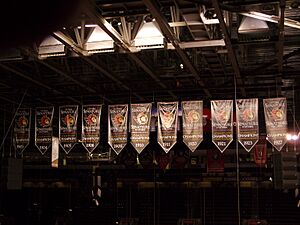
| Date | Opponent | Result |
|---|---|---|
| March 22, 1894 | Montreal Hockey Club | Montreal defeats Ottawa 3–1 |
| March 7–8, 1903 | Montreal Victorias | Ottawa wins series (1–1, 8–0) |
| March 12–14, 1903 | Rat Portage Thistles | Ottawa wins series (6–2, 4–2) |
| December 30, 1903 – January 4, 1904 | Winnipeg Rowing Club | Ottawa wins series (9–1, 2–6, 2–0) |
| February 23–25, 1904 | Toronto Marlboroughs | Ottawa wins series (6–3, 11–2) |
| March 2, 1904 | Montreal Wanderers | Ottawa ties Montreal (5–5) |
| March 9–11, 1904 | Brandon Wheat City | Ottawa wins series (6–3, 9–3) |
| January 13–16, 1905 | Dawson City Nuggets | Ottawa wins series (9–2, 23–2) |
| March 7–11, 1905 | Rat Portage Thistles | Ottawa wins series (3–9, 4–2, 5–4) |
| February 27–28, 1906 | Queen's University | Ottawa wins series (16–7, 12–7) |
| March 6–8, 1906 | Smiths Falls | Ottawa wins series (6–5, 8–2) |
| March 14–17, 1906 | Montreal Wanderers | Montreal wins series (9–1, 3–9) |
| 1909 | Ottawa goes unchallenged (ECHA champions) | |
| January 5–7, 1910 | Galt | Ottawa wins series (12–3, 3–1) |
| January 18–20, 1910 | Edmonton | Ottawa wins series (8–4, 13–7) |
| March 13, 1911 | Galt | Ottawa wins 7–4 |
| March 16, 1911 | Port Arthur | Ottawa wins 13–4 |
| March 22–26, 1915 | Vancouver Millionaires | Vancouver wins series (6–2, 8–3, 12–3) |
| March 22 – April 1, 1920 | Seattle Metropolitans | Ottawa wins series (3–2, 3–0, 1–3, 2–5, 6–1) |
| March 21 – April 4, 1921 | Vancouver Millionaires | Ottawa wins series (1–2, 4–3, 3–2, 2–3, 2–1) |
| March 16–26, 1923 | Vancouver Maroons | Ottawa wins series (1–0, 1–4, 3–2, 5–1) |
| March 29 & 31, 1923 | Edmonton Eskimos | Ottawa wins series (2–1, 1–0) |
| April 7–13, 1927 | Boston Bruins | Ottawa wins series (0–0, 3–1, 1–1, 3–1) |
- A. Montreal refused to continue the series in Ottawa, so they lost by default.
Players
Hall of Famers
- Jack Adams
- Thomas Franklin Ahearn (builder)
- Clint Benedict
- Frank Boucher
- George Boucher
- Punch Broadbent
- Harry Cameron
- King Clancy
- Sprague Cleghorn
- Alec Connell
- Bill Cowley
- Rusty Crawford
- Jack Darragh
- Cy Denneny
- Eddie Gerard
- Billy Gilmour
- Syd Howe
- Bouse Hutton
- Percy LeSueur
- Frank McGee
- Frank Nighbor
- Tommy Phillips
- Harvey Pulford
- Gordon Roberts
- Art Ross
- P. D. Ross (builder)
- Alf Smith
- Hooley Smith
- Tommy Smith
- Bruce Stuart
- Hod Stuart
- Fred "Cyclone" Taylor
- Carl Voss
- Marty Walsh
- Cooney Weiland
- Harry Westwick
Source: Ottawa Senators
Team Captains
- Frank Jenkins 1883–86, 1889–90
- Thomas D. Green, 1886–87
- P. D. Ross, 1890–91
- Bert Russel 1891–93
- Weldy Young, 1893–95
- Chauncey Kirby, 1895–96
- Fred Chittick, 1896–97
- Harvey Pulford, 1897–98
- Chauncey Kirby, 1898–99
- Hod Stuart, 1899–1900
- Harvey Pulford, 1900–01
- William Duval, 1902
- Harvey Pulford, 1902–06
- Bruce Stuart, 1908–11
- Marty Walsh, 1911–12
- Percy LeSueur, 1912–13
- Jack Darragh, 1914–15
- Horace Merrill, 1915–16
- Eddie Gerard, 1916–23
- Cy Denneny, 1923–26
- George Boucher, 1926–28
- King Clancy, 1928–30
- Frank Finnigan, 1930–31, 1932–33
- Syd Howe, 1933–34
Sources:
- 1902–1934: Sportsecyclopedia.com.
Team Scoring Leaders (NHL)
Note: Pos = Position; GP = Games played; G = Goals; A = Assists; Pts = Points
| Player | Pos | GP | G | A | Pts |
| Cy Denneny | LW | 302 | 245 | 67 | 312 |
| Frank Nighbor | C | 326 | 134 | 60 | 194 |
| George Boucher | C/D | 332 | 118 | 50 | 168 |
| Hec Kilrea | RW | 293 | 104 | 56 | 160 |
| Frank Finnigan | RW | 363 | 96 | 57 | 153 |
| King Clancy | D | 305 | 85 | 65 | 150 |
| Punch Broadbent | RW | 150 | 85 | 27 | 112 |
| Bill Touhey | LW | 225 | 58 | 36 | 94 |
| Jack Darragh | LW | 120 | 68 | 21 | 89 |
| Eddie Gerard | LW | 128 | 50 | 30 | 80 |
- Games: Frank Finnigan, 363
- Penalty Minutes: George Boucher, 604
- Goaltending Games: Alex Connell, 293
- Goaltending Wins: Connell, 158
- Shutouts: Connell, 70
Source: Total Hockey
See Also
- History of the National Hockey League
- Ice hockey in Ottawa
- List of Stanley Cup champions
- List of ice hockey teams in Ontario
- Ottawa City Hockey League
- Ottawa Senators (FHL)
- Ottawa Senators (senior hockey)
- Ottawa Senators
- St. Louis Eagles


